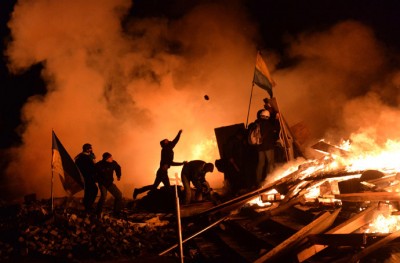Ukraine: ‘Freedom’ And ‘Democracy’ Courtesy Of The West

Following the 2014 coup in Ukraine, with EU and US politicians doing far more than operating alternative news channels, the country descended into chaos.
Far-right paramilitaries, some containing openly neonazi elements, have been used in the subsequent civil conflict or reportedly incorporated into the state apparatus, such as the police force and military.
Whereas the populations of two eastern regions of Ukraine, the Donetsk and Lugansk People’s Republics, continue to steadfastly resist ongoing artillery shelling and incursions by the Kiev regime, civilians in the rest of Ukraine live in fear of arbitrary arrest and torture by their government’s security apparatus.
Some have simply disappeared or been murdered by unknown assailants. In addition to the infamous murder of at least 48 trade unionists and other opponents of the Poroshenko regime, who died after the trade union building in Odessa was set alight by a nationalist mob on May 2 2014, many more human rights violations have occurred since.
For example, journalist and writer Oles Buzina, a critic of the Poroshenko regime and a campaigner against fascism in Ukraine, was murdered near his home in Kiev by unknown assailants.
The killing took place only a day after Oleg Kalashnikov, a former MP from ex-president Viktor Yanukovych’s party, was found shot dead.
Several supporters of the former president have also died in mysterious circumstances, ostensibly reported as suicides.
In April 2016, Russian citizen and activist Andrei Sokolov disappeared after being kidnapped by unknown assailants upon leaving a courtroom in Ukraine.
He was subsequently held for several months in a secret prison. Alla Alexandrovskaya, a former MP and head of the Kharkov branch of the Communist Party of Ukraine, was arrested and detained without trial for months.
She has been released but reportedly remains under house arrest. Journalist and blogger Ruslan Kotsaba, a supporter of the Maidan movement that led to the overthrow of the elected Yanukovych government, was arrested in February 2015 for treason after producing a YouTube video in which he refused to be conscripted into the army to take part in a civil war against fellow Ukrainians who do not wish to be governed by the Poroshenko regime.
He was released from prison in July 2016 after serving 18 months in detention.The far-right paramilitary formations which exist in today’s Ukraine were used to spearhead the overthrow of an elected, though corrupt, president in 2014.
They have since been unleashed against their (former) fellow countrymen and women, who wanted no part in the new nationalistic and xenophobic Ukraine that exploded onto the world stage in February 2014.
During the second world war, under the leadership of nazi collaborator Stepan Bandera, the Ukrainian Insurgent Army (also known as the UPA) murdered thousands of Jewish and non-Jewish Poles and Russians.
In the single region of Volyn, the UPA slaughtered an estimated 40,000 Poles in order to ethnically cleanse the region of non-Ukrainians in preparation for a future Ukrainian state, as per the 1943 decision of the UPA’s politician wing, the OUN (Organisation of Ukrainian Nationalists).
In July 1941, OUN militants participated in the Lviv pogrom, alongside the invading German troops, in which thousands of Jews were killed. After the 2014 coup, modern-day sympathisers of Bandera went about the task of trying to purify Ukraine of ethnic Russians and “traitors.”
The paramilitary organisations that played a role in the invasion of the seceding Donetsk and Lugansk regions make no secret of their ideological inspiration.
Back in November 2014, Ukraine was one of only three countries, alongside the US and Canada, which voted against a resolution passed at the UN general assembly “combating glorification of nazism, neonazism and other practices that contribute to fuelling contemporary forms of racism, racial discrimination, xenophobia and related intolerance.”
Some 115 nations voted in favour of the resolution, with 55 abstaining. A similar resolution, condemning the glorification of nazism, was approved by the UN in November 2016.
This time 131 nations voted in favour, 48 abstained and three (the US, Ukraine and Palau) voted against. (As noted by the Jerusalem Post, many of the abstentions included EU nations).
Few Westerners may be aware of Bandera’s background but undoubtedly fewer know that there is actually a Stepan Bandera museum in London: the Stepan Bandera Museum of the Liberation Struggle in London is mentioned on the website of the Association of Ukrainians in Great Britain.
While venerating Bandera, some patriotic Ukrainians screech about the crimes of the Soviet Union. Yet, in some ways, they have bought back into existence the very thing they claim to despise.
In post-coup Ukraine, billboards have appeared calling on citizens to report those deemed “separatists,” which can allegedly mean anything from not showing enough patriotic fervour to criticism of the civil war.
Offenders face lengthy prison sentences, or worse. Encouraging the denunciation of your fellow citizens for thought crimes is about as Stalinist as it gets.

